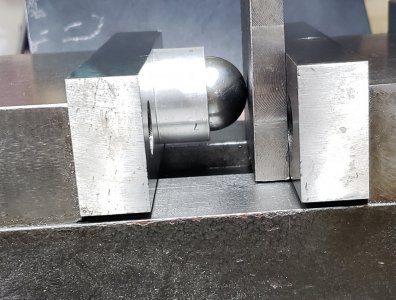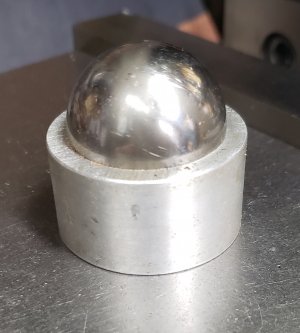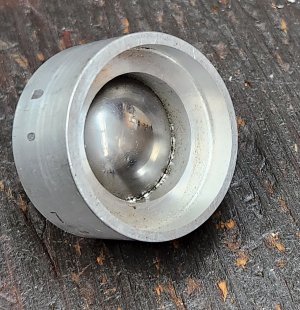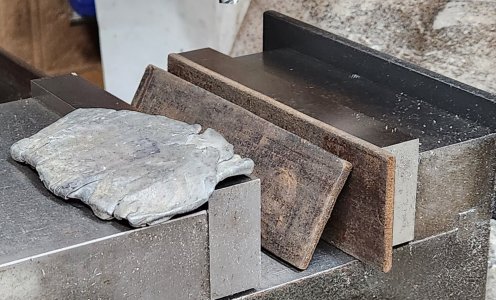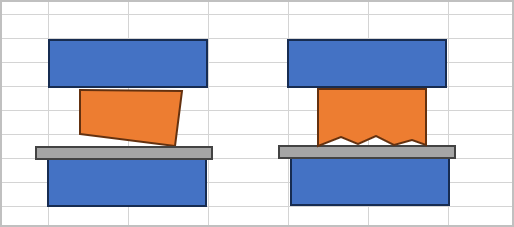To square up stock on a mill (make all sides perfectly perpendicular to each other at 90 degrees). I have always used a piece of softwood to even out the holding on my vise and accommodate irregularities on the subject block.
This piece of wood, and it's alternatives is the subject of this thread. If others want, I could do a separate thread on the whole process. (I'd bet we all would learn something with that.) I personally know a half dozen ways to do it and I'll bet there is another 10 dozen ways out there!
But that's another thread. This thread is about that Fkn piece of wood and it's alternatives.
No matter what method I'm going to use to square my stock, I ALWAYS start by picking the best of the worst surfaces to start with, put that side flat against my rear jaw, and may or may not use a parallel under the stock. Usually a parallel serves little purpose so I don't always bother. Then I put a piece of rough cut softwood on my front jaw to even out the irregularities and hold the stock firmly against the rear jaw. I may even cut the wood to form a better rough fit. Now I can machine my first real good reference face on the top surface. Sometimes with really bad stock, I have to put wood on both front and back, and then use that first top on the rear jaw with wood on the front. But that's not the norm.
As I mentioned above, I don't plan to discuss all the many ways one can square up the rest of the block in the subsequent steps. There are literally hundreds of ways to do it ranging from making a reference hat with side cuts to flipping, rotating, side cuts, partial cuts, etc etc etc Again, this thread isn't about that.
This thread is about that Fkn piece of wood. I'd love to lose that Sucker. I make a lot of firewood kindling that way.
I've seen the odd machinist use a ball bearing between the front jaw and the stock instead of wood. Often the ball was customized with a handle to hold it in place till the Jaws tighten. It seems to work just fine, and it is quite popular, but I always imagine the ball damaging my vise with the extremely high forces at the point contact of the ball and my jaw. So I've never tried it. The obvious solution to this problem is to grind a flat on one side of the ball to sit against the jaws. I don't think that is easy as it sounds and so I've never tried it either.
I've also seen many machinists use soft wires, rods, or bars. But this method requires a pretty good squareness to begin with. I seldom have that luxury. I fact, for those times that I do I prolly don't need anything!
So the question in this thread is: What do use in place of the wood? Or, do you have some magic method I've never seen before?
No YouTube links please....
This piece of wood, and it's alternatives is the subject of this thread. If others want, I could do a separate thread on the whole process. (I'd bet we all would learn something with that.) I personally know a half dozen ways to do it and I'll bet there is another 10 dozen ways out there!
But that's another thread. This thread is about that Fkn piece of wood and it's alternatives.
No matter what method I'm going to use to square my stock, I ALWAYS start by picking the best of the worst surfaces to start with, put that side flat against my rear jaw, and may or may not use a parallel under the stock. Usually a parallel serves little purpose so I don't always bother. Then I put a piece of rough cut softwood on my front jaw to even out the irregularities and hold the stock firmly against the rear jaw. I may even cut the wood to form a better rough fit. Now I can machine my first real good reference face on the top surface. Sometimes with really bad stock, I have to put wood on both front and back, and then use that first top on the rear jaw with wood on the front. But that's not the norm.
As I mentioned above, I don't plan to discuss all the many ways one can square up the rest of the block in the subsequent steps. There are literally hundreds of ways to do it ranging from making a reference hat with side cuts to flipping, rotating, side cuts, partial cuts, etc etc etc Again, this thread isn't about that.
This thread is about that Fkn piece of wood. I'd love to lose that Sucker. I make a lot of firewood kindling that way.
I've seen the odd machinist use a ball bearing between the front jaw and the stock instead of wood. Often the ball was customized with a handle to hold it in place till the Jaws tighten. It seems to work just fine, and it is quite popular, but I always imagine the ball damaging my vise with the extremely high forces at the point contact of the ball and my jaw. So I've never tried it. The obvious solution to this problem is to grind a flat on one side of the ball to sit against the jaws. I don't think that is easy as it sounds and so I've never tried it either.
I've also seen many machinists use soft wires, rods, or bars. But this method requires a pretty good squareness to begin with. I seldom have that luxury. I fact, for those times that I do I prolly don't need anything!
So the question in this thread is: What do use in place of the wood? Or, do you have some magic method I've never seen before?
No YouTube links please....

